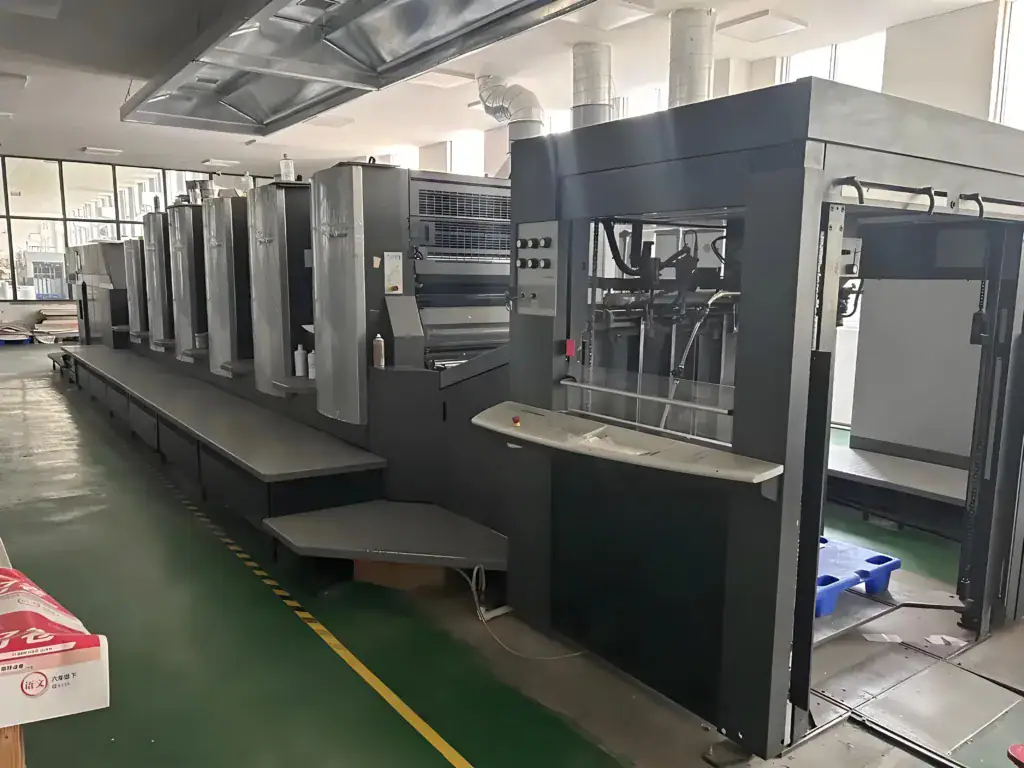Ready to unlock HUGE cost savings and tap into a world of printing expertise? This guide reveals the secrets of book printing in China, with insider tips for finding the perfect printing partner and navigating the entire process.
Book printing in China offers publishers and authors significant advantages, including lower costs, faster turnaround times, and access to high-quality printing and binding services. By partnering with a reputable Chinese printing company, you can streamline your publishing process and bring your books to market efficiently and affordably.
In this comprehensive guide, we’ll explore the ins and outs of book printing in China, covering everything from finding the right printing partner to navigating the printing process and ensuring quality control. Plus, we’ll share real-world case studies and expert insights to help you make informed decisions.
The Global Printing Landscape: A Shifting Tide
The printing industry has faced its share of challenges in recent years. Costs are rising in traditional printing hubs, and there’s a growing need for shorter print runs and faster turnaround times. This is where China steps in, offering a dynamic and competitive alternative.
China has rapidly emerged as a printing powerhouse, known for its cost-effectiveness, efficiency, and commitment to quality, which is further emphasized by its adoption of sustainable printing practices that are gaining global recognition.
But it’s not just about lower prices. Chinese printing companies offer a comprehensive suite of services, from design and typesetting to binding and logistics, making them a one-stop shop for all your printing needs.
This streamlined approach can save you time and resources, allowing you to focus on what matters most: creating and sharing amazing books.
The Chinese Printing Industry: A Closer Look

Scale and Capacity
China’s printing industry is vast and impressive. Major printing hubs, equipped with state-of-the-art technology and infrastructure, are strategically located throughout the country. These hubs house a wide range of printing companies, from large-scale operations to specialized boutique printers, catering to diverse needs and project sizes.
To give you a sense of the scale, China’s printing industry generates billions of dollars in revenue annually and employs millions of people. It’s a true testament to the country’s commitment to printing excellence.
Competitive Advantages

- Cost Advantages: Let’s face it, cost is a major factor in any publishing project. China offers significant cost advantages due to several factors:
- Lower labor costs: Compared to many Western countries, labor costs in China are lower, which translates to more competitive pricing for printing services.
- Access to affordable raw materials: China has a well-established supply chain for paper and other printing materials, ensuring access to high-quality resources at competitive prices.
- Economies of scale and efficient production: Many Chinese printing companies operate at a large scale, allowing them to leverage economies of scale and optimize production processes for maximum efficiency. This translates to lower costs for you.
- Efficiency Advantages: Time is of the essence in the publishing world. Chinese printing companies are known for their fast turnaround times and efficient production processes. They understand the importance of meeting deadlines and getting your books to market quickly.
- Streamlined supply chains and logistics: China has a highly developed logistics infrastructure, ensuring smooth and efficient transportation of printed materials within the country and internationally.
- Quality Advantages: Don’t let the competitive pricing fool you. Chinese printing companies are committed to delivering high-quality products. They have invested heavily in advanced printing technology and equipment, and many have obtained international certifications such as ISO, which is crucial for meeting the stringent requirements of the global printing industry, demonstrating their commitment to quality standards.
- Quality control systems: Reputable Chinese printing companies have rigorous quality control systems in place to ensure that every book meets your expectations.
- Service Advantages: Chinese printing companies go above and beyond to provide excellent customer service. They understand the importance of building strong relationships with their clients and are dedicated to providing personalized support throughout the printing process.
- Comprehensive services: Many Chinese printing companies offer a wide range of services, including design, typesetting, binding, and logistics. This one-stop-shop approach can simplify your publishing process and save you valuable time and resources.
Case Study: Shenzhen Mainland Printing Co. Ltd.
Let me share a real-world example of how we deliver exceptional results here at Mainland Printing. We have a strong track record of providing high-quality, cost-effective printing solutions to clients worldwide.
I recall working with a US publisher who needed to print a series of children’s books. The publisher had specific requirements for paper type and eco-friendly inks, and they needed a large quantity of books printed within a tight timeframe.
With our advanced printing technology and flexible production schedule, we were able to meet all of the publisher’s requirements and deliver high-quality printed books on time and within budget. This demonstrates how Chinese printing companies like ours can effectively collaborate with international clients to achieve successful outcomes.
The Book Printing Process in China: A Step-by-Step Guide

So, you’re intrigued by the prospect of book printing in China, but you might be wondering about the process itself. Don’t worry, it’s more straightforward than you might think! Let’s break it down step by step:
- File Preparation: This is where it all begins. You’ll need to ensure your manuscript is in the correct format and meets the printer’s specifications. This typically includes:
- Choosing the right file format: PDF is usually the preferred format for printing.
- Ensuring proper resolution: Images and graphics should be high-resolution to ensure sharp and clear printing.
- Setting the correct color mode: CMYK is the standard color mode for printing.
- Adding bleeds and margins: Bleeds ensure that your design extends to the edge of the page after trimming, while margins provide space for binding and prevent text from being cut off.
- Printing: Once your files are ready, the printing process begins. Chinese printing companies offer a variety of printing methods, including:
- Offset printing: This is a traditional method that’s ideal for large print runs. It offers high-quality results and is cost-effective for bulk orders.
- Digital printing: This method is perfect for smaller print runs or projects that require quick turnaround times. It’s also great for personalized or print-on-demand projects.
- Binding: After printing, your book will be bound. There are various binding styles to choose from, each with its own advantages:
- Hardcover binding: This classic binding style offers durability and a premium look and feel. It’s perfect for books that will be handled frequently or kept for a long time.
- Paperback binding: This is a more affordable option that’s ideal for books with a shorter shelf life or those that need to be lightweight and portable.
- Saddle-stitch binding: This simple binding method is suitable for booklets, magazines, or catalogs with a lower page count.
- Quality Control: Reputable Chinese printing companies have strict quality control procedures in place to ensure that your books meet the highest standards. This includes inspecting the printed sheets, checking the binding, and verifying that the final product matches your specifications.
- Shipping: Once your books have passed quality control, they’ll be carefully packaged and shipped to your desired destination. Chinese printing companies often have established relationships with international shipping companies, ensuring reliable and cost-effective delivery.
Tips for Smooth Sailing

To ensure a smooth and successful printing process, keep these tips in mind:
- Communicate clearly with your printing partner: Establish clear communication channels and provide detailed instructions to avoid misunderstandings.
- Provide print-ready files: Ensure your files meet the printer’s specifications to prevent delays or errors.
- Request a proof: Before the full print run, ask for a proof to review and approve the final design and layout.
- Factor in shipping time: Consider the shipping time when planning your project timeline.
By following these steps and working closely with your Chinese printing partner, you can ensure a smooth and successful printing experience.
Finding the Right Chinese Printing Partner: Your Perfect Match
Now that you’re familiar with the process, the next step is finding the right Chinese printing partner for your needs. With so many options available, it can be overwhelming to know where to start. But don’t worry, we’ve got you covered!
Key Selection Criteria
Here are some key factors to consider when choosing a Chinese printing company:
- Certifications and Accreditations: Look for companies that have obtained relevant certifications, such as ISO 9001 for quality management, to ensure they meet international standards.
- Experience and Expertise: Choose a company with a proven track record in book printing. Some companies specialize in specific types of books, such as children’s books or art books, so consider your specific needs.
- Client Testimonials and Reviews: Check online reviews and testimonials from previous clients to get a sense of the company’s reputation and customer satisfaction.
Resources and Platforms
Need help finding the perfect Chinese printing partner? Here are some resources to kickstart your search:
- Start with Google: Believe it or not, Google is an incredibly powerful tool for finding reputable Chinese printing companies. Try searches like “book printing China,” “China book manufacturers,” or “best book printing companies in China.” Pay close attention to the companies that appear on the first few pages of results, as these are often the most established and well-regarded in the industry.
- Pro Tip: Look for companies with professional websites, clear contact information, and positive online reviews. Don’t hesitate to reach out to them directly with your questions and requirements.
- Industry Associations: The China Printing and Equipment Industries Association is a valuable resource for finding reputable printing companies in China. Their website often features a directory of members, along with information about industry standards and best practices.
- Trade Shows and Exhibitions: Attending printing industry trade shows and exhibitions can be a great way to meet potential printing partners face-to-face and see their work firsthand. These events often attract leading printing companies from across China, providing a valuable opportunity to network and compare different options.
By utilizing a combination of these resources, you can confidently find a reliable and trustworthy Chinese printing partner for your book project.
The Importance of Due Diligence
Before making a final decision, it’s important to do your due diligence. This includes:
- Requesting Samples and Quotes: Ask for samples of previous work and get detailed quotes from multiple printing companies to compare prices and services.
- Verifying the Printer’s Credentials: Check the company’s background and verify their certifications and accreditations.
- Conducting Factory Visits: If possible, visit the printing facility in person to get a firsthand look at their operations and meet the team.
By taking the time to research and vet potential printing partners, you can find the perfect match for your book printing project.
Case Studies and Success Stories: Proof in the Pudding
Okay, so we’ve talked about the advantages and the process, but you might still be wondering, “Does book printing in China really work?” The answer is a resounding YES! Let’s explore some real-world examples of successful partnerships and learn from their experiences.
Examples of Successful Partnerships
- Independent Authors: Self-publishing authors are also finding success with Chinese printing companies. Mainland Printing Company has earned a stellar reputation for its high-quality printing and exceptional customer service. One independent publisher, with extensive experience working with various printers, even declared Union Printing Company to be the best he’s ever encountered.
Lessons Learned and Best Practices
These success stories highlight some key takeaways:
- Effective Communication is Key: Clear and consistent communication with your Chinese printing partner is essential for a smooth and successful project. Utilizing online communication tools, project management platforms, and translation services can help bridge any language barriers.
- Navigating Cultural Differences: Be mindful of cultural differences in communication styles and business practices. Building a strong rapport with your printing partner and being respectful of their cultural norms can go a long way in fostering a positive working relationship.
- Ensuring Quality Control and Timely Delivery: Work closely with your printing partner to establish clear quality standards and deadlines. Requesting proofs and conducting regular quality checks can help ensure that the final product meets your expectations.
By learning from these successful partnerships and implementing best practices, you can maximize the benefits of printing your books in China.
Addressing Common Concerns and FAQs
It’s natural to have questions and concerns when considering book printing in China, especially if you’ve never worked with an overseas printing company before. Let’s address some common questions and put your mind at ease:
- “But what about the quality?”
This is perhaps the most frequent concern. Rest assured, many Chinese printing companies are equipped with state-of-the-art technology and adhere to strict quality control standards. They utilize high-quality printing presses from leading brands like Heidelberg, Komori, and Mitsubishi. Furthermore, many have obtained international certifications like ISO 9001, demonstrating their commitment to quality management. - “Will I be able to communicate effectively?”
While language barriers can be a concern, many Chinese printing companies have English-speaking staff or offer translation services. Clear communication is a priority for them, and they utilize various tools like email, video conferencing, and project management platforms to ensure smooth and efficient communication throughout the process. - “How do I pay and handle shipping?”
Most Chinese printing companies offer secure payment options, including bank transfers, PayPal, and Western Union. They also have established relationships with international shipping companies, providing reliable and cost-effective shipping solutions. Be sure to clarify shipping costs, import duties, and taxes upfront to avoid any surprises. - “What about intellectual property protection?”
China has laws in place to protect intellectual property rights. Reputable printing companies understand the importance of safeguarding your copyrights and trademarks. You can also include non-disclosure agreements in your contracts for added protection. - “How long does it take to print books in China?”
The typical turnaround time for book printing in China is around 8 to 10 weeks. This includes printing, binding, and quality control. Of course, the exact timeframe will depend on the specifics of your project, such as the book’s size, complexity, and print run.
Conclusion: Embracing the Future of Book Printing
As we’ve explored throughout this guide, book printing in China offers a compelling combination of advantages for publishers and authors alike. From cost-effectiveness and efficiency to high quality and comprehensive services, Chinese printing companies are transforming the publishing landscape.
Recap of the Benefits
Let’s recap some of the key benefits of printing your books in China:
- Significant cost savings: Lower labor costs, affordable materials, and efficient production processes translate to lower printing costs for you.
- Faster turnaround times: Streamlined processes and efficient logistics ensure that your books are printed and delivered quickly.
- High-quality printing: Advanced technology, quality control systems, and international certifications guarantee exceptional printing quality.
- Comprehensive services: Many Chinese printing companies offer a full suite of services, from design and typesetting to binding and shipping, simplifying your publishing journey.
- Access to a global market: China’s position as a global manufacturing hub provides access to a vast network of suppliers and distributors, expanding your reach.
Many Chinese printing companies, known for their large-scale operations, leverage economies of scale and optimize production processes for maximum efficiency, resulting in cost-effective printing solutions.
Future Trends in the Chinese Printing Industry
The Chinese printing industry is constantly evolving and innovating with a focus on smart manufacturing technologies that are reshaping the sector.. Here are some key trends to watch:
- Green printing: There’s a growing emphasis on sustainable printing practices, with many Chinese printing companies adopting eco-friendly materials and processes.
- Smart manufacturing: Automation and artificial intelligence are being integrated into printing processes, increasing efficiency and reducing waste.
- Personalized customization: Digital printing technology is enabling greater customization and personalization of printed products, catering to niche markets and individual preferences.
Call to Action
Are you ready to unlock the potential of book printing in China? Don’t hesitate to explore the possibilities! Here are some steps you can take:
- Research reputable printing companies: Use online directories, industry associations, and client testimonials to find potential partners.
- Request samples and quotes: Get a feel for the quality and pricing of different printing companies.
- Communicate your needs clearly: Establish clear communication channels and provide detailed specifications for your project.
- Build a strong relationship: Foster a collaborative partnership with your chosen printing company for a smooth and successful experience.
Embrace the opportunities that book printing in China presents and take your publishing endeavors to new heights!







